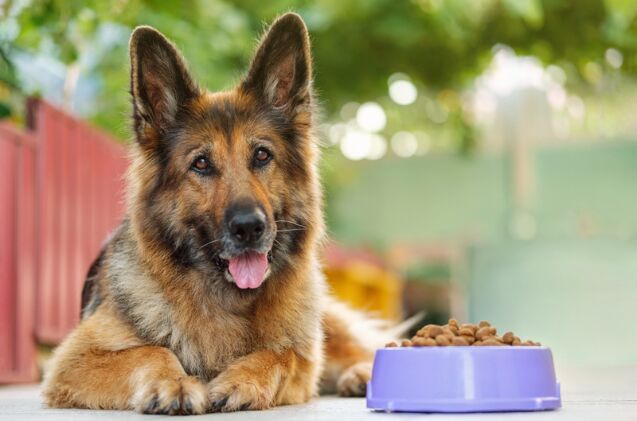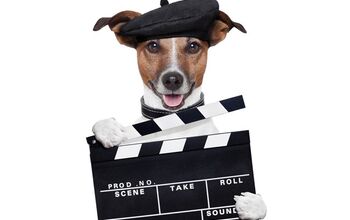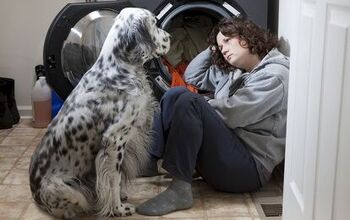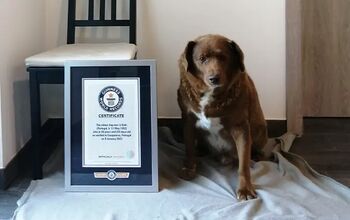How Can You Prevent Bloat in Dogs?

The most valuable tool as pet parents to keep our dogs happy and healthy is knowledge – both knowledge about how to improve their lives but also about the potential risks they may face along the way. One serious condition that every dog parent should be familiar with is Gastric Dilation-Volvulus (GDV), otherwise known as bloat.
This potentially life-threatening condition can strike quickly and unexpectedly, requiring us to be familiar with the early warning signs and when an emergency vet visit is needed.
In this article, we’ll dig into the nitty-gritty of bloat in dogs, including the possible causes, symptoms to watch out for, and steps you can take to prevent bloat in dogs. Let’s get started…
What Is Bloat in Dogs?
GDV, or bloat, is a condition where a dog’s stomach expands after it fills with food, fluid (like water), or gas. As it grows, the stomach either rotates or twists, blocking the entrance and exit, preventing your dog from digesting any food. Additionally, this condition causes blood flow to the stomach and other vital organs to be restricted, which can cause your dog’s health to deteriorate rapidly, making it a life-threatening medical emergency.
What Are the Main Causes of Bloat in Dogs?
While there has been considerable research into gastric dilatation-volvulus and its causes, the exact cause remains unknown. What experts do understand is that there are multiple factors that we can consider when determining if our pup is at risk. By understanding these potential risk factors, we can take steps to reduce the risk and keep our dogs safe.
Some of the leading potential causes and risk factors of bloat in dogs include the following:
- Eating too quickly
- Eating too large of a meal in one sitting
- Genetic predisposition
- Breed
- Age
- Exercise right after eating
However, even if you do your best to avoid all controllable risk factors, that doesn’t guarantee that your dog will never suffer from GDV. Always watch for the warning signs and be prepared to react accordingly.
Which Dog Breeds Are More Susceptible to Bloat?
Any dog can suffer from bloat, regardless of size, stature, or breed. But studies have shown that some dog breeds are at a higher risk of experiencing bloat than others. The breeds that are more prone to this condition are those that are larger with a deep-chested body structure.
This includes:
- Great Dane
- Saint Bernard
- Weimaraner
- German Shepherd
- Irish Setter
- Gordon Setter
- Standard Poodle
- Basset Hound
- Doberman Pinscher
- Old English Sheepdog
- Irish Wolfhound
- Akita
- Boxer
Dogs that weigh more than 100 pounds have been found to have a 20% risk of experiencing bloat at some point in their lifetime. It’s also important to note that dog there appears to be a genetic component to consider. Dogs who have relatives that suffered from bloat are at higher risk for developing the condition themselves. When purchasing a dog from a breeder, always double-check whether there is a family history of bloat that you should be aware of.
What Age Is Bloat Most Common in Dogs?
Dogs can experience bloat at any age, but those over the age of 7 are at a greater risk. Research out of Purdue University found that with each year of age, a dog’s risk of GDV will increase by approximately 20%. This means that dog parents with elderly pups should be even more aware of the condition.
What Are the First Signs of Bloat in a Dog?
Now that we’ve established that every dog parent should be familiar with the warning signs of bloat let’s take a moment to talk about these signs. What should you be watching for to keep your dog safe? If your dog develops bloat, time is of the essence – the sooner they reach a veterinarian and receive the necessary medical care, the better their chance of survival.
Early warning signs that you should watch out for include the following:
- Restlessness or pacing
- Pale gums
- Swollen, hard, or distended abdomen
- Abdominal pain or reluctance to be touched
- Retching or attempting to vomit with no success
- Spitting up white foam
- Excessive drooling
- Rapid breathing or panting
- Racing heart rate
- Inability to stand or collapse
If you see any of the above signs or have any reason to suspect that your dog may be experiencing bloat, drop everything and get your dog to your veterinarian or the nearest emergency clinic as soon as possible.
7 Tips We Use to Prevent Bloat in Dogs
There is much conflicting advice out there regarding what does or doesn’t increase a dog’s risk of bloat. We were told that feeding a dog with their dish on the floor for a long time could increase the chances of developing the condition. However, since then, this point has been debunked as experts found dogs eating from elevated dishes are just as likely to experience bloat.
There are still some significant steps that we can take that will reduce the risk. Even if it only has a minor impact, every step in the right direction is positive!
With three dogs in our house, all German Shepherd mixes, the possibility of bloat is always at the forefront of our minds. As such, we have often had discussions with our veterinarian, learning new ways to make their safety a top priority. Here are our biggest tips:
Feed Your Dog in Multiple Small Meals
One of the known risk factors for bloat is eating too much all at one time. Of course, we also don’t want to underfeed our dogs, leaving them to suffer from nutritional deficiencies or malnutrition. The best solution is to take the daily recommended meal and split it up into several smaller meals throughout the day.
With our dogs, we stick to 3 meals coinciding with our mealtimes – breakfast, lunch, and dinner. To ensure we aren’t overfeeding and putting them at risk of obesity, their meals are carefully measured with their total daily caloric needs in mind. It certainly didn’t take them long to adjust to this meal, and now, the boys are quick to remind us if it’s time for a meal and we’re not right on top of it for them!
Keep Food Bags or Bins Safely Stored Out of Reach
A potential risk factor that is often overlooked is your dog’s food supply. You can be diligent with measuring your dog’s food out each meal, but if they get into their dog food bag and gorge on the food there, it won’t matter! When storing your dog’s food between meals, consider doing so in a way that keeps it safely locked away from their curious little paws (and mouths).
One easy solution that makes it easy to ensure that your dog’s food is safely contained is to use a container like the Vittles Vault. Not only do they restrict your dog’s access to their food, but they also keep the food sealed, preventing excess moisture and keeping it fresh. We then store our Vittles Vault in a wooden shelving unit with a door, where we also store their bowls, slow feeders, food puzzles, and more. This keeps everything conveniently close at hand during mealtimes.
Pay Attention to and Limit Excessive Drinking
Just like overeating, drinking too much water all at once can cause the stomach to expand. Keep an eye on your dog when they are drinking, especially when they may be tempted to drink excessively. This is most common after intense exercise or on hot days. While your dog should always have access to fresh, cool water, you may need to limit how much is accessible at any time. If you choose this approach, carefully check your dog’s water throughout the day and refill it frequently.
Use a Slow Feeder Dish, Food Puzzle, or Snuffle Mat
One risk that is well within your control is the speed at which your dog eats. Studies have shown that dogs who eat too quickly have a five times greater risk of bloat than those who eat slowly. Of course, we can’t just explain to our dogs that they should eat slower and expect them to listen… Instead, we need to take steps to slow them down during mealtimes.
Two of our three dogs eat so quickly when left to their own devices that they all but inhale it. So, how do we slow them down? When feeding Indiana and Lucifer, we never use a regular dog dish. Instead, we rotate through several options, including a slow feeder dish, various food puzzle toys, and snuffle mats.
Slow-feeder dishes like the Fun Feeder Slo Bowl from Outward Hound have ridges and obstacles inside that your dog must eat around. This naturally slows them down. To change things up occasionally, we will also use food puzzles and interactive feeders like Outward Hound Nina Ottosson Dog Twister. We love this line of puzzles because they are sorted into four levels, from Easy to Expert, allowing us to choose which puzzle best fits each of our dogs easily.
If you are looking for an option that doesn’t require buying new products or breaking the bank, try dropping a couple of tennis balls into your dog’s dish with their kibble. They will have to move the tennis balls around as they eat, slowing them down and preventing them from inhaling their meal.
Keep Your Dog Calm for 1 Hour After Each Meal
If you have a high-energy dog, like our little man Lucifer, this one can be a challenge, but it’s essential. After each meal, keep your dog calm and relaxed for at least 1 hour. Some dogs naturally curl up after filling their stomachs, taking a post-meal nap. If this isn’t the case for your dog, there are steps you can take to prevent them from running around and increasing their risk.
We had to put Lucifer in his crate with a chew toy after meals as a puppy. It was the only way to contain the never-ending puppy energy. As he grew older, we started working on teaching him the “place” command, which requires him to stay on his blanket wherever we place it until he is given a release. Once again, we would give him a chew toy to relax with, so it wasn’t seen as a punishment or negative experience. Another option that could help encourage your dog to settle would be to put them on a leash.
Separate Playful Pups Following Mealtime
Do you have more than one dog? If so, there is a good chance your playful pups may encourage one another to play, breaking the rule of no activity right after a meal. The best option with multiple active or high-energy dogs is to keep them separated for a bit after mealtimes. This will eliminate the temptation to run around and play.
Don’t worry, you aren’t hurting their relationship or denying them the chance to have fun. They will be just as eager to play together after a short time out when you release them.
Consider Preventative Surgery
There is a preventative surgery that has been gaining attention among dog parents with high-risk dogs called Gastropexy. In this procedure, the stomach is sutured to the abdominal wall. This will prevent the stomach from being able to twist. While this surgery can be done at any age, most vets will recommend doing a gastropexy at the same time that they spay or neuter a dog if they are a high-risk breed. If you are interested in more information, contact your veterinarian.
Final Thoughts: How to Prevent Bloat in Dogs
Gastric Dilation-Volvulus (GDV), or bloat, is a serious and often life-threatening condition that we should be aware of as responsible dog parents. While there is still much research to be done to understand the condition and the exact causes better, there are steps that we can take to prevent it from happening and keep our dogs safe. Feed your dog several small meals throughout the day, using a slow feeder dish if needed to slow them down, and keep them calm after mealtime.
If you suspect your dog may be suffering from bloat, seek immediate veterinary care. Remember, early treatment is the best chance of survival you can give your dog!

Britt Kascjak is a proud pet mom, sharing her heart (and her home) with her “pack” which includes her husband John, their 2 dogs – Indiana and Lucifer – and their 2 cats – Pippen and Jinx. She has been active in the animal rescue community for over 15 years, volunteering, fostering and advocating for organizations across Canada and the US. In her free time, she enjoys traveling around the country camping, hiking, and canoeing with her pets.
More by Britt
























